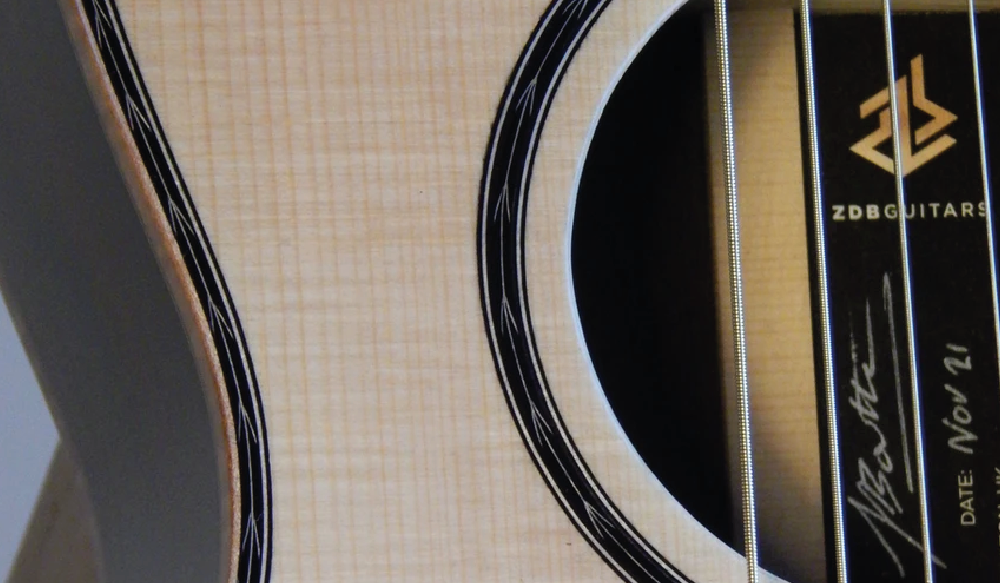
High Point Episode 001:
Zac Booth, the perfectionist and talented luthier
I am very happy to welcome you to the very first episode of High Point.
For this episode, we visited Zac booth in Great Eastern in Leicestershire, which is roughly in the middle of England.
A few years ago, Zac set up ZDB Guitars to live from his passion, making high-end and bespoke guitars.
Zac told us a lot of interesting things during the episode, and I can tell you the creative process and the guitars are incredible.
You can see some pictures of the workshop and the guitars on his website www.zdbguitars.com or on this page below.
You can either read the transcript of the episode below or listen to it on the following channels:
You can listen to the podcast on the following platforms:
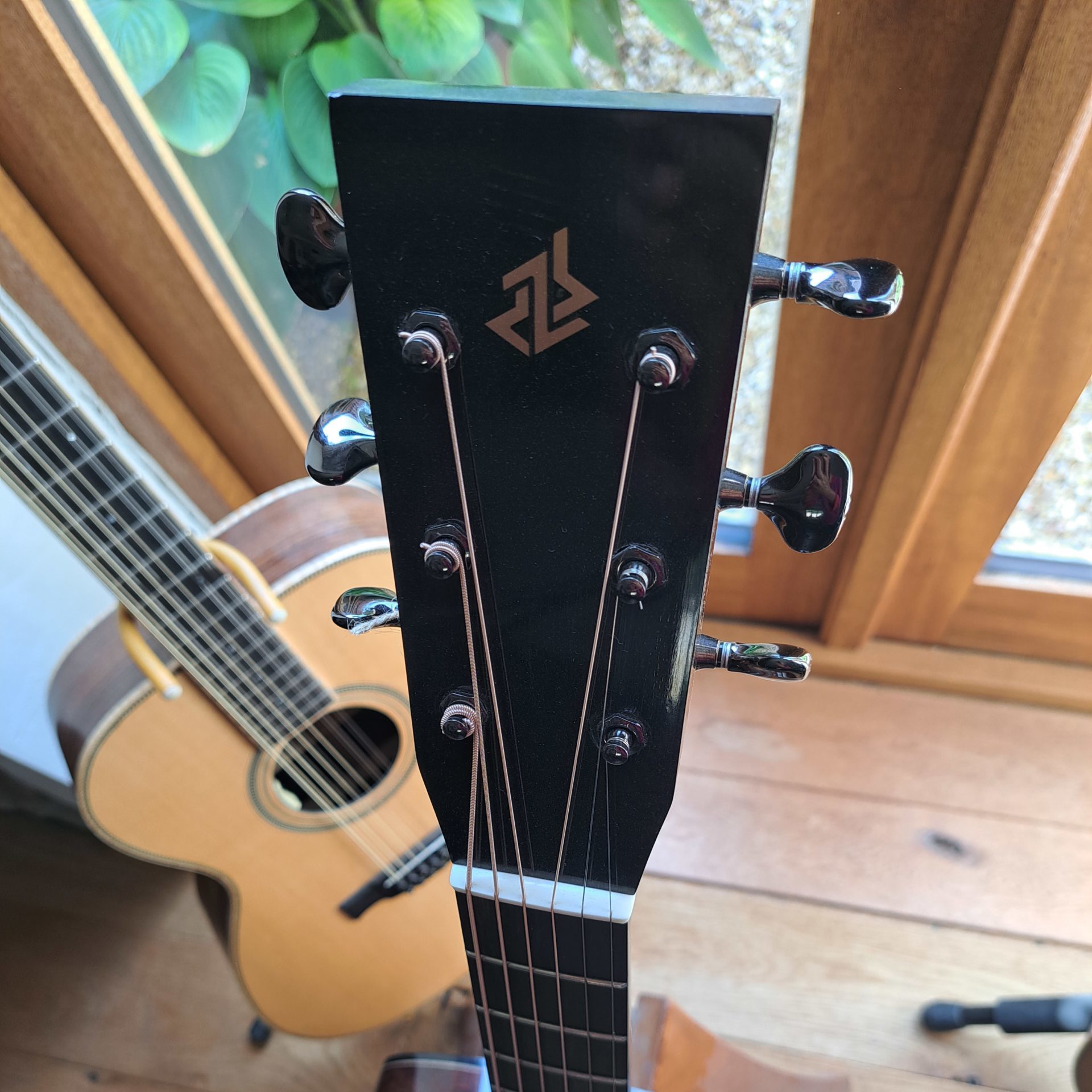

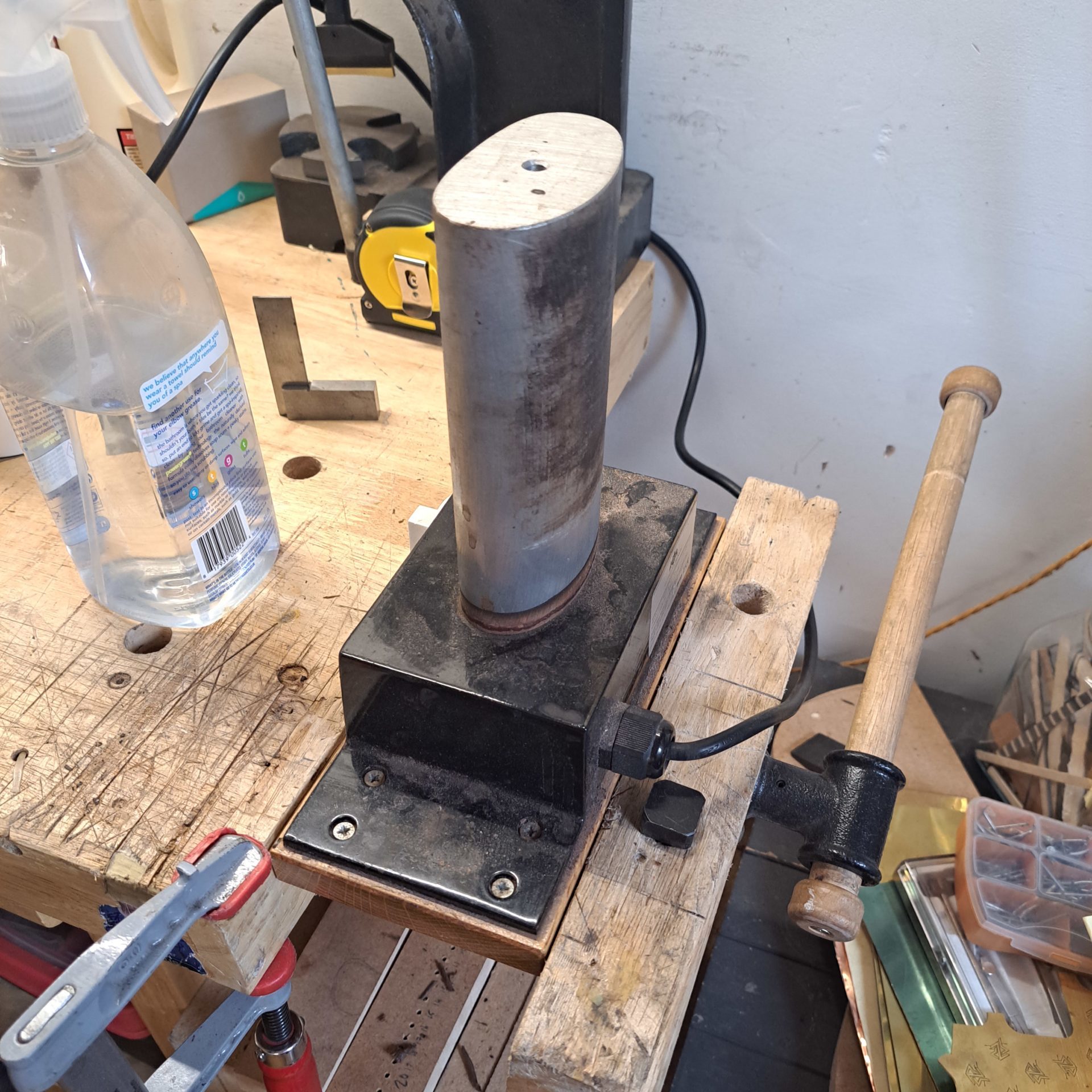
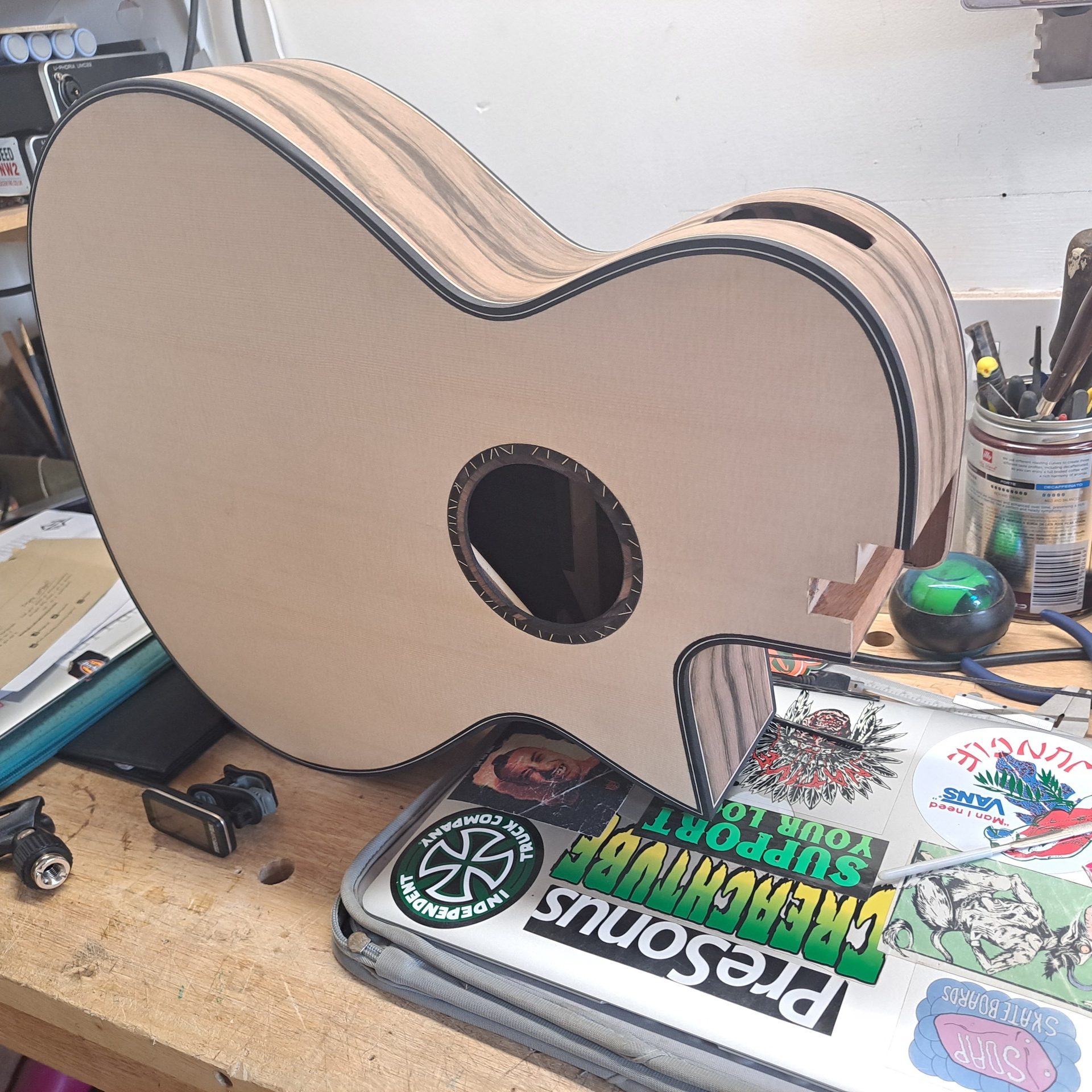

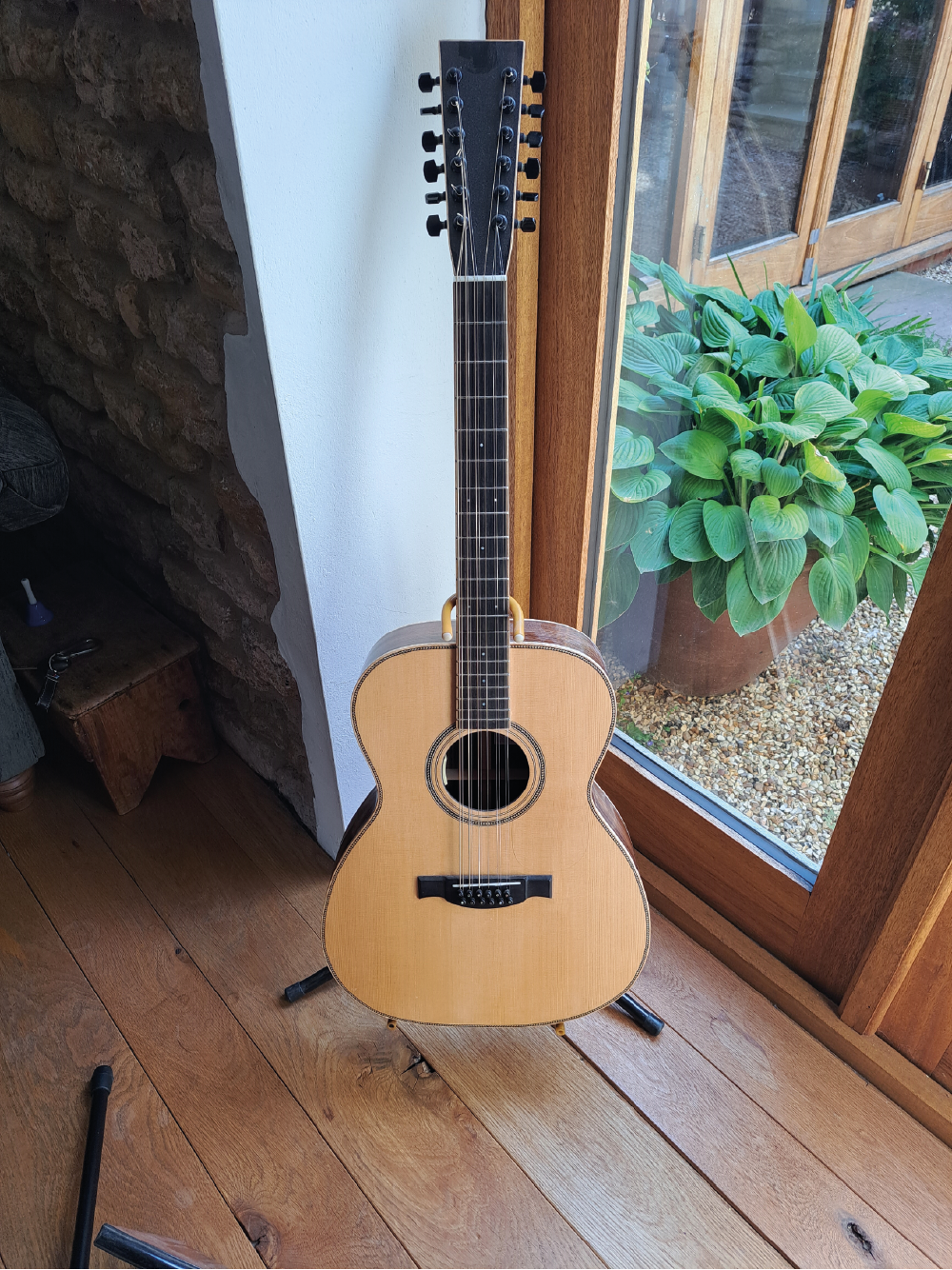
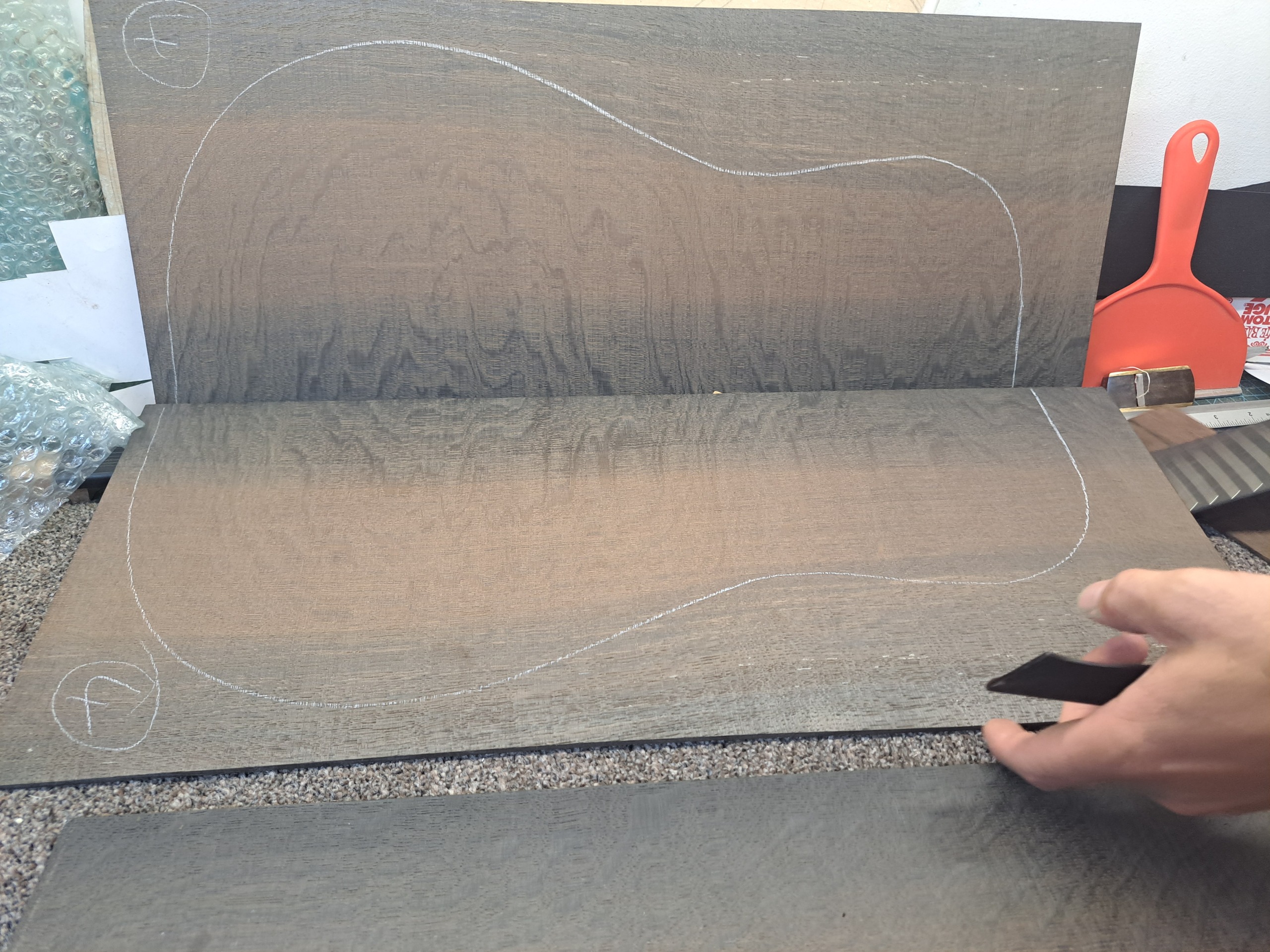

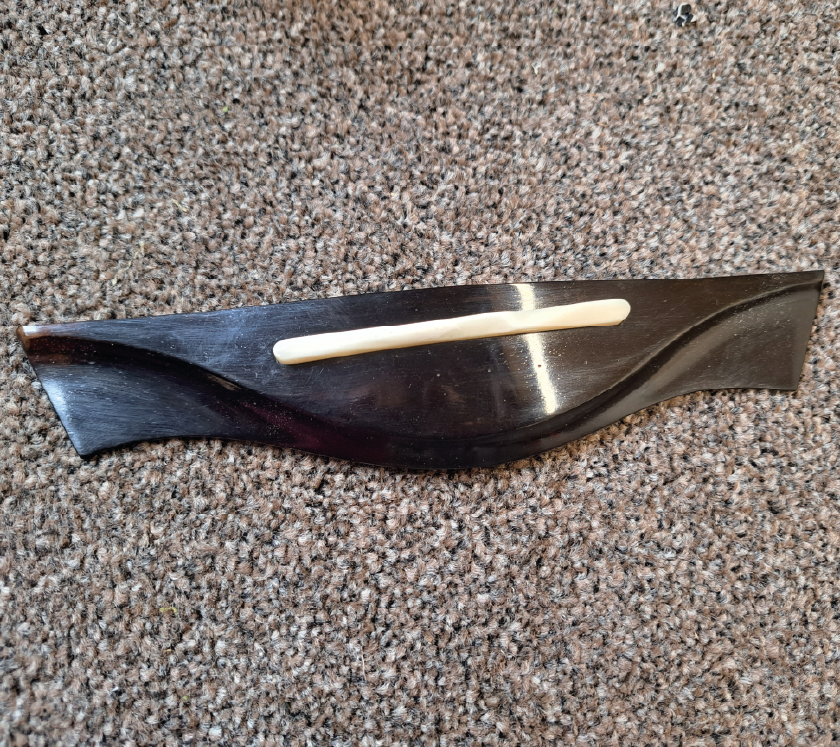
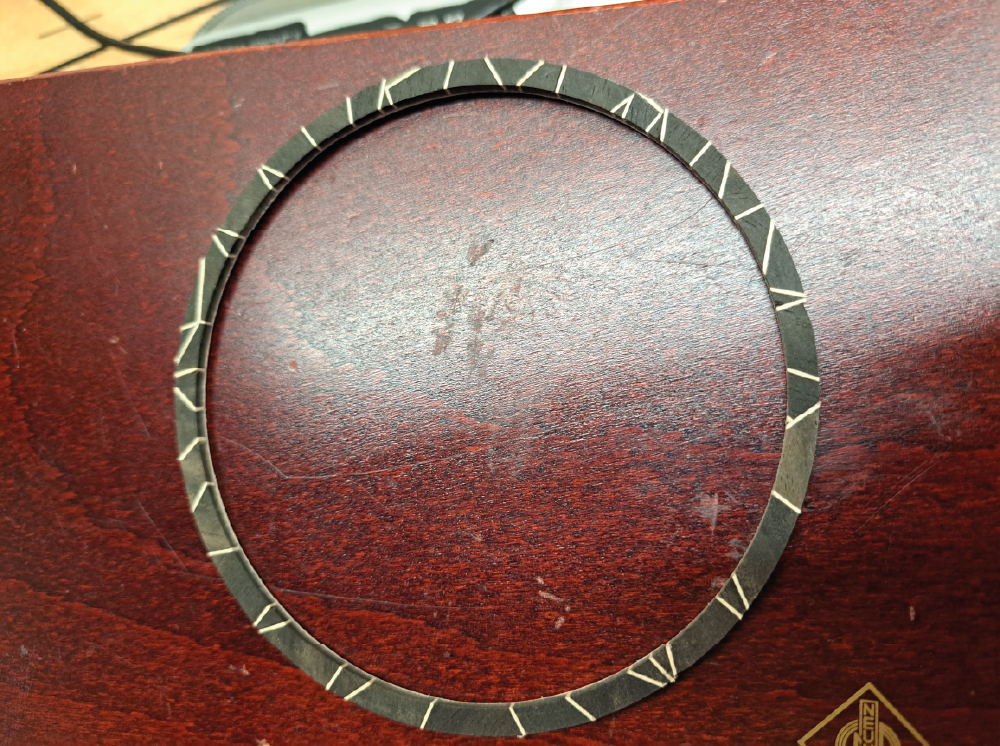
Marc Fuzellier: Hi Zac.
Zac Booth: Hello.
MF: how are you?
ZB: I’m very good. Thanks.
MF (1:25): Can you tell us who you are?
ZB: Yeah, so I am Zac booth. I make acoustic and electric guitars at the minute from my house in Great Eastern, Leicestershire. Yeah, I’ve currently got moving into a new little unit though, so things should be, production-wise, speeded up a bit, hopefully.
MF: Have you always wanted to do it? Did you or were you making guitars when you were a kid or instruments?
ZB: I’ve kind of been building random things since I was a kid out of wood and all sorts of stuff really. Built a couple of strange instruments when I was a kid that kind of got me into doing it. I studied art and sculpture and music at college. So that kind of drew me onto the path of wanting to make guitars. And yeah, has kind of carried on from there.
MF (2:30): And so what did you study after that? Where you went to uni…
ZB: Yes, so I went to, I did an Art Foundation course after college, which kind of helped me decide what I wanted to do. And then I was searching for courses, and I found this musical instrument degree at London Met, which I thought I’ve got to do that because it’s kind of combining all the things I’m into, all the things I like. So I went there, started that in 2015. And, yes, sadly we’re the last year to do it because they shut the course down from lack of funding and from not enough people being on the course. Which was kind of sad after about 100, 150 years or something.
MF (3:27): Did you stop it because there wasn’t enough business? Or there weren’t any jobs?
ZB: Maybe that could be another part to be fair, another reason.
MF: Maybe that’s a question to ask them.
ZB: Yeah, I know, yeah. They were protesting about trying to keep it going, but nothing. They ended up shutting it down, I think. So yeah, it did kind of play to our advantage because we had the workshops to ourselves.
MF: You’ve got less competition.
ZB: And yeah, less competition. But, it’s kind of sad, but hopefully. I’ve been thinking of starting an evening class to teach people how to make guitars as well. So that could be another nice little way to make money. But yeah, and teach and keeps the guitar making alive, I guess.
MF: Am sure some people would be interested in that. So they could contact you.
ZB: Yeah, I’d love to do that, to be honest.
MF: Cool. So, the uni, were they just teaching you how to make guitars or other instruments as well?
ZB: So, it is mainly guitars and other fretted stringed instruments. We had people making, someone made a mandolin and archtop guitars, classical guitars other people made older kind of a 19th-century copies of 20th-century guitars that were kind of the double neck. I can’t remember what they’re called now, on the tip of my tongue.
MF: You’ll find it again.
ZB: It’ll come back to make. Yeah, all sorts of different fretted instruments really.
MF (5:24): And so, do you know, if you want to do drum kits, for example? Do you know what, where you would need to go? Is it taught still?
ZB : I don’t know about drum kits too much, to be honest. But I’m sure that there’d be people who teach it. There wasn’t a course where I went [to uni] for drum kits, but I think they used to do [it]. There are a few, there used to be quite a few different musical instrument-making courses about 20, 30 years ago, at that same college, when it was the London furniture college. They did woodwind instrument making, loop making, violin making, and stuff like that. But I don’t know about drum kits really. They might have done something like that.
Jake Cottier (6:12): Do you think there are obviously transferable skills? Work? Different techniques, but a lot of the knowledge you have could be applied to other things.
ZB: Yeah, definitely. You could probably figure out how to [do it] because it’s, I don’t if drum kits are laminated at the sides, so you could probably make moulds, and it helps you figure out how to build other things as well, I guess. She has the skills of working with wood. But yeah am sure I could knock off a drum kit at some point. But yeah, I don’t know. It’d be interesting to try and figure out how to do it though. Because, yeah, I’m sure. There are so many ways you can change how a drum sounds. By tweaking little bits, changing the size of the drum, the materials.
MF (7:11): Yeah, definitely. And so how do you keep up with your skills? Do you? I Presume you still need to? There are a lot of skills you need to learn. How do you learn to do them on YouTube? [Did you] have somebody? Try new things? Working with people?
ZB: So, YouTube and the internet are so helpful, so lucky we have that. Because yeah, I can’t imagine learning new things without it to be honest. Because it’s, it’s such a good tool.
MF (7:44): So can you learn how to make a guitar from scratch on YouTube?
ZB: You probably could, to be honest, I mean, you’d probably have to fix a lot of mistakes and figure out how to figure out the hard way rarely, but I think learning most of my skills at uni and college, just learning how to work with wood kind of does really help. But little things like little tips and stuff. There are so many good YouTube videos and other videos on the internet that you can take tips off or tips from. Am sure you can figure things out yourself, I guess. It’s a good way of learning but it’s
JC: Almost like a community kind of, of luthiers and instrument makes. So you can sort of share information and help each other out.
ZB: Yeah, there are quite a few. There are quite a few Facebook groups that I’m in actually, You do get quite a lot of posts people posted on there, the guitar makers and luthiers but sometimes there’s some crap on there as well. You do see some people, I can’t think of any examples at the minute but people were just making guitars out of things they shouldn’t be making guitars out of really like but yeah, there’s also loads of things that are really helpful on there as well.
MF (9:20): Is wood the preferred material or do you think there are other materials that could be used? [Or] tricky to use, so they can’t be used yet for guitars? Have you explored any of them?
ZB: I’ve only really kind of only learned the traditional way. So I’ve just been working with wood but I know a lot of [people], I’ve seen a few makers that have been making guitars out of carbon fibre and stuff like that. There’s a guitar company that make like aluminium necks and like folded metal bodies, which is crazy. It’s more electric guitars, but you do get carbon fibre. I’ve seen a few carbon fibre acoustic guitars
MF: Do they sound okay?
ZB: I think they do sound good actually but I’ve not I’ve not played one in person I’ve only kind of seen videos and stuff but I think they sound good from what I’ve heard but I just don’t see how how it would, I don’t know how it would compare to a traditionally made kind of Spruce top acoustic guitar because I think that’s just, I don’t know if people are kind of stuck in the old ways but I feel like they’ve they found the best way to do it 100 years ago or so, but when they’re making them.
JC: There’s a charm to wood, like natural resources. Unlike some of the wood, I know you told me, are hundreds and hundreds of years old.
MF (11:02): How do you get it? How did you get that wood? How would you find it?
ZB: I’ve got a few suppliers I get wood from, to be fair. I’ve had some trouble in the past getting wood from Spain and stuff because there’s restrictions on certain woods like Rosewoods. It’s a right pain, you’ve got to apply for permits and stuff and pay stupid fees when it comes into the country but things like Madagascan Rosewood I’ve had I’ve built a few guitars out of and until before we were in Europe, like when was it 2020 or 2021 we left, and since then I’ve it’s been so difficult before then I could just get it ordered and it would come straight in but now I ordered a set last year and for a guitar, I had to make [out of] Madagascan Rosewood and that. Yeah, I had to apply for it because it’s sites is the site is it’s like appendix three on site ease or something which is which means it’s like an endangered species. So you can’t actually export it without having certificates and stuff. Okay, which is a right pain, so since then, I’ve been trying to just source all my wood from the UK because it’s just so much easier. And it’s, I guess it’s supporting businesses over here as well.
MF: That’s quite interesting.
ZB: Yeah, I’ve also, I’ve been, I’ve got a set of Bog Oak, that’s the one I was talking to you about, Jake, I think it’s carbon dated to 5400 years old, which is older than the Egyptians. So it’s just an old oak tree that was submerged under a bog, which is it has been dug up 5000 years later.
MF: How do they find it? How much is it? I bet it costs a lot of money.
ZB: It’s quite expensive, but it’s kind of the same price as your Rosewood or any other kind of high-end guitar wood really. The farm is in, it’s from kind of around Norfolk. Around there. I think the farmers must just like kind of drive over it in the tractor, or something or when they’re ploughing the fields and hit this big log that has been buried for like 5000 years. There are a few people who go around digging them up and kind of drying out the logs. Because they’ve been submerged they have just soaked up so much water, that it turns the wood black. Yeah, it looks amazing.
MF: I’d be interested to know, from the stage of discovery, and realising “Oh, that would be good for [a] guitar” and there are the process people behind it, saying yes, you can use it and processing it, to make it.
JC: Yeah, you join the dots and thought I’d like to make a guitar out of [it].
ZB: Yeah, I think it’s weird isn’t it? I mean, normally that’d be used on the back and sides of an acoustic guitar. So normally, you’re after like a dense, pretty dense wood that can be [used] instead of a soft wood, so it’d be a hardwood oak. I mean, I don’t know if people make [them]. I’ve never made an oak guitar. But I’ve seen that like Bog Oaks, kind of quite a few makers are making guitars out of bog oak now because it’s quite widely available in the UK because it’s found here. But yeah, it’s crazy.
MF (14:35): And so what’s the benefit of it for the guitar? Is it easier to work [with]? Does it make the guitar sound better, to have a specific timber?
ZB: From the guitars I’ve heard made out of Bog Oak, they kind of sound a bit loosey kind of, but it’s just it’s a desirable wood, I guess. I don’t think it quite as the sound of the Rosewoods, but, it’s yeah, it’s still a really, really nice guitar.
MF: For those listening, there’s a few guitars just in front of us. But are there any of those guitars that have it?
ZB: None of those has it actually. I’ve not built one yet out of Bog Oak. I’ve got a set that I’m going to be building one with, but I’m looking forward to seeing what it sounds like. I’ve only seen a couple of guitars built out of it. So it’s, uh, it’ll be interesting to see how it turns out with one of my designs.
MF: You could do some tests and measurements. Measurements of what’s the difference between a guitar made with that wood?
ZB: It’d be good to compare them, definitely.
JC: I guess, whilst the sound is a big priority in instruments, also, the way they look? As you say, they are pieces of art in their own right. Just to look at. So it’s also something that you must think about when you’re designing a guitar. Of course, it needs to sound good, but it’s got to like the business. Which they do.
MF: They look amazing. I think that adds to the…
ZB: It inspires the player, I think as well, if you’ve got something that you actually want to play, because you love it, you’re in love with it almost. So it’s like, it makes you want to play more, and it’ll make you a better player if you play it more. So. Yeah, kind of. Yeah, how nice. It’s a hard one to go on.
MF (16:52): So who do you make guitars for? Do you make them for specific people? Or do you sell them in shops? Or online?
ZB: Yeah, a bit of both, really. I’ve got a few guitars in Moonflower guitars in Oakham, which is a great shop. [They] sell all sorts of guitars, handmade guitars, all sorts of budgets. And yeah, that’s the only shop. I have my guitars in at the minute. But I’ve also been doing a few commissions from people who want certain guitars made out of certain things. And I’ve just had a new commission actually, which is, which is going to be really exciting because that’s going to be the first one I’ve had that someone’s ordered with my shape that I’ve been kind of developing over the last few years. So that’s that’ll be a really interesting how that turns out. But yeah, I’ve also been getting quite a lot of repair jobs through this shopping in Oakham as well, which has been very helpful.
MF (17:56): Do you have a website? Where people can contact you?
ZB: Yeah. So you can find all my details on my website, which is zdbguitars.com. Or Instagram @zdbguitars as well. I think all my contact details are on there to be honest.
MF: We’ll put all the contact details in the description.
ZB: Oh, yeah, wicked.
MF (18:25): Can you take us through the process of creating a guitar? What do you start with? And how long does it take?
ZB: Yeah, so it’s kind of, so I’ll go through you, whoever wants the guitar, I’ll go through the timber selection with them, choose the wood for the back and sides, top, neck, fingerboard, all of that kind of stuff. And then now I’ll basically, I have to use all the traditional methods still so it’s, it takes a while but I’ll hand plane all the pieces of wood to thickness so the back and the sides they’ll usually go down to about two, just under two and a half millimetres, around 2.3 millimetres thick. So that takes a good amount of elbow grease with the hand plane. And same with the top, that was slightly thicker, that’s normally around two and a half millimetres or 2.7 maybe. Then I do all the bracing, which is another design I’ve been developing on for the bracing design. I’ve kind of come up with my own quad X brace for the top which normally it’s just a single x. It’s quite hard to explain without seeing it.
MF: Yeah, we will put some pictures [up].
ZB: But I’ve kind of been inspired by there’s another there’s a Scottish guitar maker David Anthony Reed who makes incredible guitars. And he’s done a lot of kind of weight relief, bracing and experimental bracing which I’ve kind of take a bit of inspiration from and develop my own design from that really.
MF: And that design, you said, your dad has made your…
ZB: Oh yeah, my dad helped me with my logo, actually. So he’s a graphic designer. So he’s, yeah, it’s very handy. I mean him about helping me with my logo and my website and stuff like that. So, yeah, that’s very, very helpful, I’ve got to say.
MF: What’s next in making the guitar?
ZB: So yeah, so I’ll then do the neck. There’s a lot of playing into thickness. So it’s a lot of hand planing. And it takes [up] a lot of the time. And, obviously, they finish it and stuff like that. But yeah, the whole construction of the inside of the guitar as well. Instead of a lining along the, to join the like the top to the sides, or the back to the sides, I use these blocks, little triangular blocks, which I have to individually hand stick on. Which, I think, it makes the guitar, the construction, slightly, it does make the guitar lighter, and it gives the top or the back more surface to stick to the sides. So it should if essentially make it stronger and lighter. And then, you can work on connecting the neck to the body. So there’s a block inside the body, which you have to make a join to the neck, which I do a mortise and tenon kind of thing, which is hidden. But I’ve been working on a new neck design where the heel of the neck is actually set into the body, which I’ve not seen anyone do this yet, so hopefully or catch on a bit and yeah, get a few people interested. So that’s an exciting new design I’ve come up with. So yeah, we’ll have to get some photos of that up as well, actually.
JC: It adds a sort of modern kind of look. You know, acoustic guitars [have] quite a traditional shape. To retain that…
ZB: It’s not changing too much.
JC: But it’s kind of more modern looking.
ZB: It’s kind of function over form as well, because you do, the reason why it is like that is so you can access the frets higher up the fingerboard. But it also does look nice. So it’s yeah, it’s, I mean, it takes a bit of inspiration off all sorts of designs. I’m into designing [in] all kinds of forms, like whether it’s cars and whatever really, like you can kind of take inspiration off all of these things, really.
MF: Is that you [who] came up with… I mean, I’m not a guitarist, so I don’t know. But is that you who made the hole, had the idea of the…
ZB: The soundboard? So there’s, yeah, there are quite a few makers are doing this at the minute. And I’ve yeah, I’ve kind of just taken inspiration from them.
MF: For those who can’t see, there’s a hole in the soundboard. They can hear better, what they play?
ZB: That’s it, yeah. So it’s essentially a monitor for the player who’s playing the guitar. This is yeah, a little sound hole in the side. And you can hear the difference when you put your hand over it as well. You can sound completely different. While you’re playing it. It’s Yes, but I think it is a nice touch. I mean, it’s not everyone’s cup of tea yet and you don’t need it, but it’s, I feel like it does. Yeah. It just gives the player a bit more clarity while they’re playing, I yes.
MF: Yeah. Cool. And you also do other types of guitars, electric guitars, is that the same process?
ZB: It is a bit different to be honest, electric guitars, because it’s all solid-bodied. So it’s more kind of, a lot more drilling and routing and stuff like that for pickup cavities and stuff. So it is less work I’d say, an electric guitar, but it’s yeah, I feel like building acoustic guitars is a little bit more satisfying because you have a little bit more control on how it sounds. Whereas an electric guitar is more about the electronics and the pickups and the amp you’re plugging it into, really. I mean the woods will affect it very slightly but on an acoustic guitar. The choice of woods will affect how it sounds a lot. A lot more really.
MF (24:59): So good. Can you give us a price range for your guitars?
ZB: Yeah, so my guitars, as they’re completely hand built, I can’t really build one for less than about three and a half thousand really. Three, three and a half is kind of what they start at. For a parlour guitar, [it] is maybe a little bit cheaper, but yeah, it’s it takes around, I’d say 300 hours to build one.
MF: That’s quite a lot. Yeah, it’s a takes a while. Plus the materials?
ZB: Plus the materials, yeah. So it will be about cost around 1000 pound in materials. So I’m probably if I’m, if I’m spec-ing one up, if I charge 1000 pound for materials, I’ll still be in about 10 pounds an hour or less at the end of the day, but it’s yeah, it’s what I love doing. So it’s, I have to take a loss at the minute, but hopefully, I’ll be able to sell it for a lot more one day.
MF (26:00): So what’s the benefit of having one of your guitars compared to another cheaper guitar? And what are the differences? I presume they must be cutting costs on some elements and sounds not as good?
ZB: I mean, there are a lot of differences in the materials and a lot of cheaper guitars nowadays, they’re all laminated wood. So instead of having a solid top and solid back and sides, they’re all kind of basically plywood, laminated tops and backs. But I mean, there are a lot of them still sound really good to be honest, for the price as well, you can’t really go wrong. But my guitars are more aimed for enthusiasts and professionals rarely who are. And they’re almost like, what’s the word? Heirloom kind of guitars as well. So they want to be passed down through generations, I guess it’s kind of something that’s yes, it didn’t really lose a value I’d say. Whereas either you can buy any old guitar from a shop for 500 quid or whatever and it will be a fantastic guitar but it’s just enough, [doesn’t have] the same character really, or? They won’t sound as good either really. They sound good, but I mean it’s a hard one to put a finger on how the difference in sound but when you’re playing it, you can tell the difference.
JC: These are wholly personal instruments really. You know, like you said, you go through timber. And for many other things in terms of the design so someone can get exactly what they want. Yeah, can’t that’s not something you can just go into the shop and buy… No one else is gonna have that guitar that you have, it’s very personal.
MF: Yeah. And I guess, also, only those who play the guitar would be able to tell whether they sound really good or not. It’s the same for when you play drums or you can definitely hear the sound between those that are really cheap and those that are more expensive and there’s more effort and there are more refined materials. Same as pianos, I won’t name any brands but you can clearly hear the return of the different pianos, the low-ends. So when talking about sanding, can you make us a few demos?
ZB: I ‘ll play a few chords I’ve got a, an old Washburn [inaudible] compare him to so we could, we’ve got a, what should we try first. Shall I play the Washburn first so we can hear the difference?
JC: So this is?
ZB: This is a cheap Washburn, kind of dreadnought.
JC: Like a beginner guitar really? So as you’re just getting into it [inaudible]
ZB: [playing guitar] Doesn’t sound in tune, does it? Maybe I shouldn’t play this one.
MF: Just play a few chords or something and you play the same chords [on the other guitar].
JC: This guitar isn’t one of Zacs, just to be clear.
ZB: Yeah, maybe I will play another one. You kinda get a gist for a couple of chords. But let’s try playing the same chords.
Yeah, I’ll use that Madagascan one actually. That’s probably the nicest-sounding one.
[inaudible] How long it’ll ring for as well.
Bit of an idea, there. Shall I try that with the Indian Rosewood one?
JC: Yeah
ZB: See what that sounds like. Not the most interesting thing to play
JC: Maybe if you do like an open ear something? To hear how long it rings for?
ZB: You can get a bit more of an idea from just playing a chord I think, don’t you?
JC: So the sustain…release…however you want to call it, what in the design of the guitar influences how long and how it will be helpful?
ZB: I think the bracing on the top, like the soundboard, that makes that talk. I’m a bit far away from the mic, aren’t I? Yeah, the build on the soundboard like the bracing will affect that [the] most I think. I think the back and the sides and the timber choice on the back and sides are probably not quite as influential on the sustain or release of a chord or note. But I think yeah, the thinner the top, obviously I don’t want to be too thin because it will lose its kind of structure. But there’s a nice margin where it can sound really good, I think on the thickness of the top and then obviously that the brace and if it’s over braced, and all the brace is really thick pieces of wood basically, it’s going to dampen and deaden the top. But if it’s this kind of [design], it’s is like a happy medium, I think. On all the braces I do, on the [guitars], they’re all tapered from the… so the treble half of the soundboard, all the braces are quite tall and thin, kind of triangular, kind of profile term. And then they’re all tapered to a low kind of, curved round, a bit wider on the bass side, which is a…this is kind of a theory that David Anthony Reid, who’s another guitar maker I mentioned earlier, he’s been basing his bracing off that theory. So I’ve, I think it works. I mean, the guitars have made sound amazing in my opinion. So it’s, it’s worked for me, but…
JC: The proof is in the pudding as we say.
ZB: But it does, it does mean it takes a bit longer to make the braces. It’s got its kind of disadvantages, the bloody, how long it takes to make, but…
MF (5:33): Do you make everything yourself? What are the pieces that you have to make yourself and other pieces that don’t require you making them?
ZB: Yeah, so I pretty much make every component myself apart from,
MF: That’s pretty amazing
ZB: Bridge pins and the machine heads. So I’ll make, yeah, I’ll make, under the fret wire, obviously I don’t make that. But I do all the fretwork, and pretty much every component I make. I think that gives it another kind of handmade touch almost because you’ve got one person focusing on every component rather than a whole guitar being on a production line where someone’s doing one bit someone is doing another bit if you know what I mean. So I think that that kind of that does impact on how the guitar sounds as well, probably.
MF: Yeah, it’s, it’s crazy that you’re making everything yourself. And how did you learn it? Did you learn it during your course? Did you learn it after? And you gradually learn new skills? How do you keep up with that?
ZB: So I’d say I probably did learn the majority of it on my course. But certain bits, I’ve kind of, yeah, I’ve done my way. Because I thought I could improve [on] how I did it before if you know what I mean? So there’s always room for improvement, I guess when you making [guitars]. So it’s just kind of figuring out how to do it’s perfect – there are no imperfections. And that’s the really hard bit because of the amount of things that I’ve had to redo. So many times I’ve glued the neck on and had to heat it up, get the iron on it and take it off because the angle is not quite right to the body. Or that I’ve glued the bridge on and had to…it’s lifted up at the back because it’s a… I’ve found that I used to do quite a lot of pyramid bridges, which is kind of like the old Martin design. And I found that because there are only about an inch thick or deep [or] wide. However, they do lift up at the back. So it’s kind of altering the design features so they’re a bit more effective, I guess.
MF: Yeah. It does look like you really need to be a perfectionist and an absolute perfectionist to make guitars like this. Like earlier you were showing us how the two pieces just clam to each other. It’s just a 10th of a millimetre close in detail. It’s just incredible.
ZB: Yeah, it’s, it’s tricky. A lot of it a lot of the joins you’ve got to do, you’ve got to get a piece of rizla and you if you can get that underneath, it’s still not quite, the joints not there. So you’ve got to get it until it’s that’s bang on. So that’s frustrating that when you take a little bit too much of one side and then it’s, there’s a gap the other side, it’s just kinda [hard].
MF (8:43): And that leads on to me asking you have you had any failings? Do you have to redo some pieces like completely from scratch? Or like there’s a guitar, you have to like, throw away because it’s not been done properly, or somebody’s not happy with it?
ZB: Yeah, so I’ve got a guitar in there that’s kind of half-built that I started probably around two years ago. And it’s, I’ve heard a lot rounds, I need to basically rebuild the whole thing because wood’s always constantly moving, depending on the humidity and temperature. And like the water content and stuff in the air…That guitar [there] basically, the back sunk in. So I need to take the back off and re-brace it. And then the top sunk in a certain place as well. So I’ve got to basically take, it’s basically a full body of a guitar that’s been put together but I’ve got to completely take it apart and redo every bit of that basically, so that’s been sat in there for the last year and a half because I’ve just not got around to taking it apart and redoing it yet.
MF: So you’re just losing motivation?
ZB: [I] lose the motivation for it, exactly. On that one. I’m going to take it completely apart and make it into my new shape because it’s…that was going to be a kind of a triple-o Martin style guitar. But because I’ve kind of rebuild it, I’m going to change it a bit. I think so, yeah, I’ve got to finally figure out how to get the motivation to try and start that again.
MF: I presume that guitar is just you [who] wanted to make it? It’s not been an order?
ZB: No, that’s not an order. Yeah, no, that was just, I had another set of wood and I thought I’d make another one rarely, basically, yeah, in a bit of free time. But yeah, I’ve just not got around to do[ing] it anymore and that really, which is frustrating. That is the most frustrating thing I think about building guitars because I’ve had a few of the guitars that I’ve built, where the back sunk in, and you’ve got to take the back off and re-brace it. And it’s just like, you got to take a step back to take two steps forward or whatever, yeah. It’s like that with a lot of things, I guess. And yeah, if you come across mistakes and things that yeah, the wood…with movement of wood as well, it’s not even a mistake. One time I left a guitar for about two weeks over Christmas time and came back and the whole bucket instead of being radiused out it had gone in so it was like a domed in so I had to redo that as well. It’s annoying.
MF: It’s crazy how sensitive instruments are and obviously they go out of tune depending on the temperature. So I guess when you try to make a guitar and the humidity or the temperature changes massively.
ZB: It’s a nightmare. I even a few weeks ago, I was doing the channels for the binding. And I went and did it outside because it was so hot. But it was probably a bad idea in the end because I went outside and the heat outside literally, I saw it happen in front of my eyes, it just sent a crack all the way down the back of a guitar. Yeah, so down a piece of ebony, it was an ebony on the back and sides. And I could just hear it here [cracking noises]. Like, just and then it just started appearing and it ah god. It’s so annoying because it just gives you so much more work to try and fix it then. Yeah, but yeah.
MF (12:21): How is it to start making guitars? Did you have an order as soon as you left your course? Or you were already making one? And is it a hard job? Are you making a living out of it? You’re looking to do it [full time]? What’s your…?
ZB: Yeah, so I couldn’t I couldn’t do it straight away as like you say, I didn’t have any orders or anything like that. So when I finished my course I started a carpentry job, cabinet making, down in London. And I did that for a year and then move back up here to try and focus on this while I was doing other little jobs basically. And then I got in with this shop in Oakham that just opened up [called] Moonflower guitars, and then they sorted me out with quite a bit of repair work and setups. So that allowed me to do that, while I was building a few kinds of prototype guitars that I could take photos of in basically, yeah, bring a bit of attention to my guitars that I was making. And since then, I’ve managed to get a few orders in, sell a few in the shop. So that’s yeah, it’s kind of just about making a bit of it. But I’ve also yet been doing other jobs on the side. So hopefully I can just start getting into get into doing it a bit more full-time and yeah, sell a few more guitars. But that’s the hard bit is, selling them I guess, I can make them I mean, the last few weeks I’ve been up till midnight working on [it], kind of just to get it done. Because I don’t have the time to do them in the day when I’ve got repairs on and stuff like that because that’s the kind of priority when it comes to earning money.
MF (14:19): Do you have… are any events where you can go and show your guitars?
ZB: Yeah, there’s this… quite a few guitar shows actually, I need to get down to a few more. There’s one in Northampton that I went to a few months ago but there’s quite a few. There are quite a few around the country really that you can go to. I need to start booking a few stands for them now. I’ve got a few more guitars available here. So it’ll be a bit…definitely good to get to a few of them.
MF: Yeah, it’s the hard bit. You’ve got your products but then people need to know about it. I mean to me to talk about it, show it more.
ZB: That’s it, yeah. Get it to people.
MF: Do you get any orders or interest from your website or Instagram?
ZB: I’ve had quite a few repair jobs and people contacting me about doing bits on their guitar and stuff like that. But I’ve not had too many, had many orders from online actually, because most people who are, have been interested in, have seen my guitars in the shop in Oakham and then they’ve contacted me because they want something similar or they want a guitar made to their specification or whatever. But yeah, it’d be good to get work on my website a little bit more to get.
MF: More traction?
ZB: Yeah, a bit more traction online. I’ve just done my website myself, though Wix. So it’s kind of you kind of limited to? I don’t know, I use good works. To be fair, actually. It’s gonna start a website.
MF: It’s good to start brochure websites. Then if you need to do more detailed websites.
ZB: You need more custom kind of pages and stuff.
MF: But yeah, that’s how you need to do [it] and I guess you need to present a lot on your Instagram and constantly showing what you’re doing.
ZB: It’d be good to get a YouTube channel up and running, actually, and get videos of people playing my guitars because I’ve had a few people who have contacted me asking for sound clips and stuff like that, which I’ve just not got around to recording. I need to get a good player and get some sound clips.
MF: You could even start a vlog showing how you do things. And people will understand the effort that’s behind it.
JC: A time-lapse?
ZB: Yeah, time-lapses are good as well.
JC: However many days, you know, 300 hours in like 20 minutes or something.
MF: Do that with your phone.
ZB: I’ve done a few time lapses. But I’ve just not got around to doing a lot of filming. As always, I’ll start doing something and I’ll just completely forget to set my phone up or set the camera up. But it’s just getting into the routine of doing that, I think, isn’t it?
MF: It takes a lot of effort. I mean, I haven’t done any YouTube stuff, but I know it takes some time.
ZB: And then you got the editing side as well, all that stuff. But it would be good to do to be fair, I would like to do it.
MF: It’s probably worth it. Especially if you’ve got really high-end guitars, then you’ve got much more visibility on YouTube, or any other social media.
ZB: Yeah, definitely
MF: So Jake, have you got any other questions?
Yeah, we could wrap it up.
ZB: Good to chat anyway.
MF: It was great.
JC: The 12…? [inaudible]
MF: Oh, yes. Yeah, I wanted to hear that as well.
ZB: I’ve forgotten to play that, I’ll play a few chords
[plays guitar].
MF: Just to summarise your work. Can we contact you? We can contact you on Instagram. But can you give us your details?
ZB: I think mainly on Facebook as well actually. ZDB Guitars, it’s the same on all of them, actually. I’m probably on Instagram more than Facebook, to be honest. I normally just set my posts on Instagram to post on Facebook as well.
JC: And if people want to, perhaps, see because, what was the name of the shop?
ZB: Yeah, if you want to try any of them out, they’re in Moonflower Guitars in Oakham, in Rutland, it’s a great little music shop.
JC: If you’re ever there and would like to play some nice guitars.
MF: It’s a very nice town, a British town.
ZB: Countryside town, definitely.
MF: Good to spend some holiday there. Cool. Well, cheers Zac.
ZB: No worries, pleasure.
MF: All the best for the future.
ZB: Thank you very much.
MF (49:42)
Bye.

